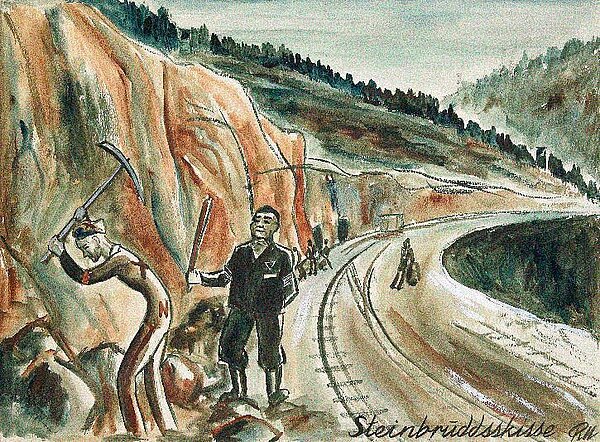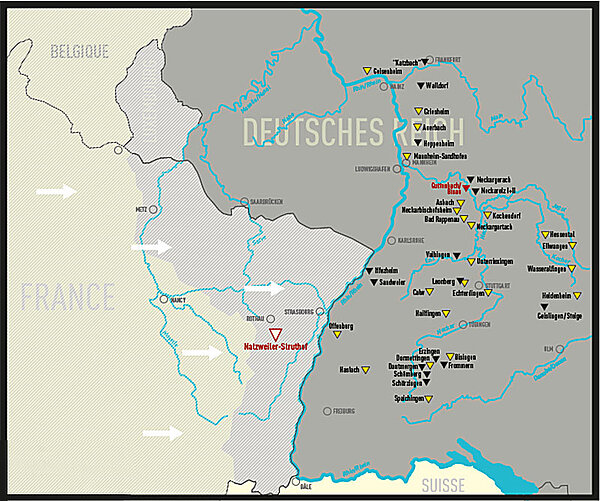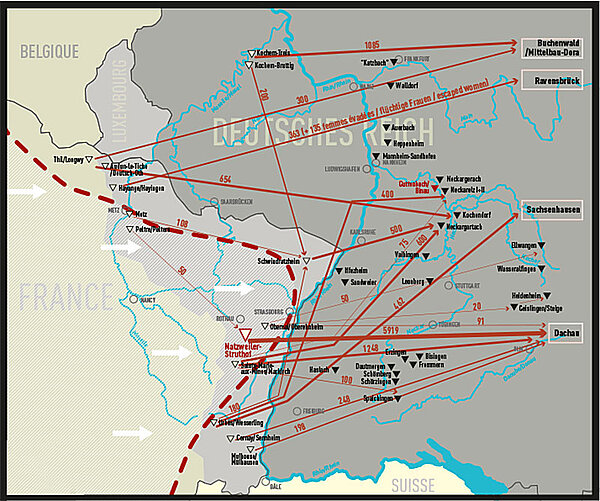The "Natzweiler Concentration Camp" moves to the Neckar
The Development of the Natzweiler Concentration Camp 1941-1944
The Natzweiler-Struthof concentration camp was developed in May 1941 near a location where pink grantite had been found - at an elevation of 800 meters in the Vosges mountains. In 1940, the Alsace had been annexed by Nazi Germany, and belonged to the Reich. Natzweiler-Struthof belonged to the 21 "main camps" - in other words, they were counted in the same group as Dachau, Buchenwald or Mauthausen.
Initially, there were only a few hundred concentration camp prisoners living in Natzweiler. In the second half of the war, more and more satellite camps were developed, and the number of prisoners rose sharply. In 1944, more than 50 satellite camps on both sides of the Rhine belonged to Natzweiler, including all camps of the "concentration camp complex on the Neckar".
The concentration camp prisoners at the locations of the satellite camps worked for SS-businesses and armament companies, military airports and extracting oil from oil shales. At the same time, they were mostly used as "construction prisoners", therefore not directly in production.
Termination of the Camps on the Left Side of the Rhine 1944
As a result of the advancement of the allied forces, the SS-leaders ordered the evacuation of the main camp in the Vosges. The 6,000 concentration camp prisoners located there were transported to Dachau.
The satellite camps situated on the left side of the Rhine were also dissolved: From September until November 1944, the SS evacuated 6,500 prisoners of These camps to Dachau, Buchenwald, and so on, as well as to Natzweiler´s satellite camps on the right side of the Rhine. At the same time, the SS opened almost 20 more satellite camps in Baden and in Wuerttemberg in the last months of the war. On the accompanying map, the new camps are marked in yellow. The already existing camps are marked in black.
During the transition phase from September until November 1944, the commandant Fritz Hartjenstein, and parts of the administration remained in Natzweiler-Struthof. Other departments were temporarily transferred to Dachau or were worked on at various satellite locations. That is how, for example, the postal administration ended up in Neckarelz.
Transfer of the Headquarters to Guttenbach and Binau
On November 22, 1944, the SS finally left Natzweiler-Struthof with the last 16 prisoners. The headquarters and the political division (ie: espionage-defence) moved to Guttenbach on the Neckar across from Neckargerach. The SS-administration moved to Binau, and the SS-motor pool to Neunkirchen.
With these moves, the commandant Hartjenstein attempted to seek proximity to the Neckarelz concentration camp complex; The "Natzweiler concentration camp" would be administered and commanded from Guttenbach and Binau. Although the geographical location of the camp no longer existed, the "Natzweiler Concentration Camp" remained in name for administration purposes. At the beginning of January 1945, the Natzweiler complex was made up of 33 satellite camps (on the right side of the Rhine) and 22,500 concentration camp prisoners, including approximately 1,000 Jewish women.
The End of the Natzweiler Concentration Camp in Spring 1945
The death rate increased in the remaining satellite camps in the fall of 1944. The situation especially worsened in the winter of 1944/45: The nutrition situation worsened as a result of the war and the hard winter. It became more and more difficult to organize the satellite system, because although they were expanding on the one hand, they were beginning to fall apart on the other hand.
In March and April 1945, the "Natzweiler concentration camp" finally closed. The SS sent 20,000 concentration camp prisoners in trains and on "death marches" to the Dachau, Buchenwald and Bergen-Belsen concentration camps, and toward the Alps. On the (enlargable) map on the left, the number of prisoners and their movements are highlighted. Thousands lost their lives in these last weeks of the war.
The Natzweiler concentration camp had what one could call, a "double ending" - the first on the left side of the Rhine in the fall of 1944, and the second on the Rhine´s right side in the spring of 1945.




